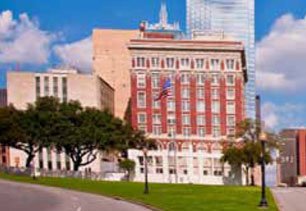Probate Court Building History
Dallas County Probate Court Building History | ||
 | ||
| The Dallas County Probate Courts are located in the Dallas County Records Building Complex consisting of three buildings. These buildings include the old Dallas County Criminal Courts Building, the Dallas County Records Building and the Records Building Annex. The Probate Court is located in the old Criminal Courts building and Probate Courts 2 & 3 are located in the Records Building Annex. Both buildings that house the Dallas County Probate Courts face Dealey Plaza. | ||
 | Dallas County Criminal Courts BuildingThis site was purchased by Dallas County in 1913 for a new jail and courts building. It was designed by local architect H.A. Overbeck. The steel-framed building, finished in 1915 (costing $585,982) is clad with granite, terra cotta and brick, exhibiting a renaissance revival styling. The upper six floors housed the jail, which was designed for 200 prisoners. Additionally, the second floor contained two large courtrooms, one of which is still in use as The Probate Court of Dallas County. In 1964, Jack Ruby was tried in the East courtroom for killing John F. Kennedy assassination suspect, Lee Harvey Oswald. |  |
 | Administration and Records Building |  |
 | Dallas County Records Building AnnexThe Dallas County Records Building Annex was erected in 1955 when W.L. Sterrett was the county judge. The seven story building faces Elm Street and Houston Street. The architects and engineers of the building were Smith & Warder, Broad & Nelson and Jack Corgan Associated. |  |
 | “Whites Only”While it may be difficult for many people to understand today, signs such as these were once quite common throughout the South. Beginning with the ending of Reconstruction in the last quarter of the 19th century and continuing until the Civil Rights Act of 1964 abolished this reprehensible practice, local laws and customs prohibited African-Americans from, among other things, using the same water fountains, staying at the same hotels, and eating at the same restaurants as whites. The Dallas County Commissioners Court has chosen to leave the remnants of this sign in its original location to remind us of this unpleasant portion of our history – if we cannot remember it, we will not learn from it, and we will not appreciate or respect the rights and the responsibilities that we enjoy. |  |
 | Roll of Honor PlaqueThe following heroes of Dallas County who sacrificed their lives on the altar of freedom at Pearl Harbor on December 7, 1941 are remembered by this plaque that hangs in the Records Building: Leander Cleveland King; William Earl Marshall, Jr.; Tom Dick Neal; Richard Perry Rush; Lonnie Moss Hartson; William Lee Spencer; James Clifton White; Earl Joe Donnell, Jr.; Joseph Gillespie Smartt; James Ammon Beaumont; Robert Wayne Carlisle; Ballard Burgher Cobb; Robert Ashner Herriott, Jr.; and Robert Dawson Jenkins. | |
 | Jack Ruby TrialOn November 22, 2013 Dallas will mark the 50th anniversary of the assassination of President John F. Kennedy with a ceremony in Dealey Plaza. This picture of Jack Rudy’s Trial is currently hanging in the Probate Court. From left to right, starting in the foreground, the participants are: Phil Burleson (Defense Attorney), Melvin Belli (Defense Attorney), Joe Tonahill (Defense Attorney), Frank Watts (Assistant D.A.), Jim Bowie (Assistant D.A.), and Henry Wade (District Attorney). Behind the District Attorney table and to the right of the Judge’s Bench, Jimmy Muleady (Court Reporter). The back row from left to right is Doug Cranstaff (Deputy Sheriff), Doug Walsh (D.A. Investigator), Bill Decker (Sheriff), Nell Tyler (Bailiff), Bob Mabra (Bailiff), Bud Clover Adkins (D.A. Investigator) and an unidentified woman. The judge presiding over the case was the Honorable Judge Joe B. Brown. | |
 | Dallas County Criminal Courthouse, early 20th Century | |
QUICK LINKS
LOCATIONS
EMPLOYEES
-
You must be on the network to see these links.

